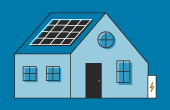NOTE: We’ve written an updated review of some of the current popular home battery products. Check it out here.
Home energy storage is a relatively new technology that’s steadily gained interest over the past few years, and it’s hard to know where to start when comparing all your options. Top solar batteries like those made by Tesla and Sonnen make it possible for homeowners and businesses to store their excess solar energy instead of sending it back to the grid, so that when the power goes out or electricity rates spike they can keep the lights on.
Continue reading




